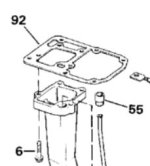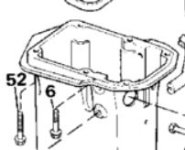Jupiter Dinghy
Regular Contributor
I just fell on this 87 motor, I thought I'd give it a shot to see what kinda progress OMC accomplished between 79 (the most "recent" 9.9 I've owned so far) and 87.
After replacing lower unit/impeller, recoil starter, and unclogging an obstruction in the water circulation, I got it to run, and pretty good too.
1st question: I checked the temp with an infrared gun at the head, and I noticed that the bottom cylinder is running hotter than the top one (between 140 & 145) while the top one measures around 105..... is that typical? Or a cause for concern?
2nd question: On my 70's puppies, there is a certain amount of throttle that you can (and must) open to start up, which is limited by the gear selector mechanism that stops the rotating plate just as the throttle opens up, and to prevent engine damage by revving up too much in neutral.
Well on this 87, there is NO throttle opening at all. It starts fine without any throttle mind you, and the throttle does engage all the way in forward and reverse, but I was surprised that there is no way to throttle it up at all in neutral, unless you manually open the throttle by pushing the linkage with a finger.
Is this a factory setting? Or a cause for concern?
Thanks.
After replacing lower unit/impeller, recoil starter, and unclogging an obstruction in the water circulation, I got it to run, and pretty good too.
1st question: I checked the temp with an infrared gun at the head, and I noticed that the bottom cylinder is running hotter than the top one (between 140 & 145) while the top one measures around 105..... is that typical? Or a cause for concern?
2nd question: On my 70's puppies, there is a certain amount of throttle that you can (and must) open to start up, which is limited by the gear selector mechanism that stops the rotating plate just as the throttle opens up, and to prevent engine damage by revving up too much in neutral.
Well on this 87, there is NO throttle opening at all. It starts fine without any throttle mind you, and the throttle does engage all the way in forward and reverse, but I was surprised that there is no way to throttle it up at all in neutral, unless you manually open the throttle by pushing the linkage with a finger.
Is this a factory setting? Or a cause for concern?
Thanks.





